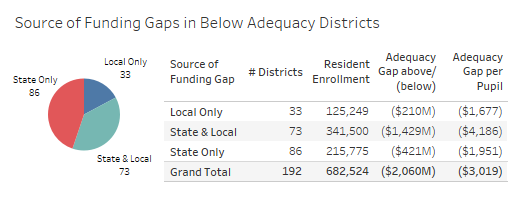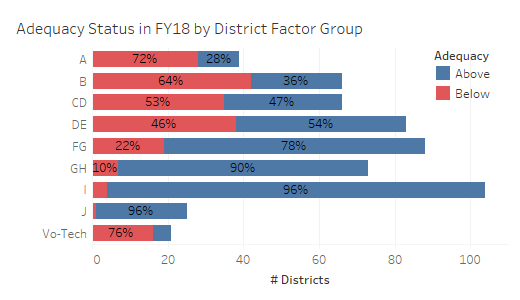192 NJ DISTRICTS NOW SPENDING BELOW “T&E”
A new Education Law Center analysis shows that 192 New Jersey school districts, serving over 682,000 students, are spending below “adequacy” in 2017-18 under the School Funding Reform Act (SFRA), the state’s weighted student funding formula. In total, these districts are below adequacy by over $2 billion dollars, which amounts to $3,019 per pupil.
The centerpiece of the SFRA is each district’s “adequacy budget,” based on the cost of educating all students to achieve state standards, along with the cost of programs for low-income (at-risk) students, limited English proficient students, and students with disabilities. In 2009, the New Jersey Supreme Court ruled that, when fully funded to each district’s adequacy budget, the SFRA formula can deliver the essential resources – teachers, support staff and programs – necessary to provide a “thorough and efficient” (T&E) education, as mandated by the State Constitution.
The degree to which districts are below adequacy varies greatly, with some just below their SFRA target, but others behind by thousands of dollars per pupil. Twenty-six districts are spending more than $5,000 per pupil below their adequacy target, and four districts are below adequacy by over $8,000 per pupil (East Newark, Atlantic County Vocational, Salem County Vocational, and Guttenburg). Click here for a list of all districts by adequacy status.
Why Districts are Below Adequacy
ELC’s analysis shows that the 192 districts are below adequacy as a result of gaps in state aid or local property tax revenue – or a combination of both – as calculated by the SFRA. Thirty-three districts are below adequacy because of local revenue gaps, while 86 are below because of state aid gaps, and another 73 are below because of a combination of state and local revenue gaps.

The 159 below-adequacy districts with state aid gaps are owed over $1.7 billion in state aid. Twenty-eight districts are owed more than $5,000 per pupil, and three districts are owed more than $8,000 per pupil (Bound Brook, Passaic County Manchester Regional, and Atlantic City).
The 106 below-adequacy districts with local gaps are owed over $1 billion in local revenue. Fourteen of the twenty with the largest local gaps are county vocational schools, but these districts make up some of that lost revenue by collecting tuition payments from sending districts. The non-vocational districts with the largest local gaps are Jersey City, Cape May City, Fairfield Township (Cumberland), Vineland, West New York, and Harrison. Click here for a list of all below-adequacy districts and their funding gaps.
Below and Above Adequacy Districts
The 192 below-adequacy districts, which educate 50% of New Jersey’s students, are in every county and span the range of district types, from low to high poverty, urban to suburban and rural. The remaining 385 districts in the state are spending above the SFRA’s adequacy level, or more than is required for T&E.
Using the NJ Department of Education’s classification of districts based on community wealth and socio-economic status (district factor group or DFG), below-adequacy districts are found in every DFG. However, districts in the poorest DFG’s and the vocational districts are more likely to be below adequacy (DFG A through CD), while the wealthier districts are more likely to be above adequacy (DFG DE through J). For example, 72% of DFG A districts are below adequacy compared to 4% of DFG J.

For a sortable list of below-adequacy districts and state and local funding gaps, click here.
“Adequacy is at the heart of the SFRA and why the formula provides a thorough and efficient level of resources for all students,” said Danielle Farrie, ELC Research Director. “In making any adjustments to the formula, even in the annual State Budget, lawmakers must make sure that the under-adequacy districts move towards, and not away from, their SFRA adequacy targets.”
Press Contact:
Sharon Krengel
Policy and Outreach Director
skrengel@edlawcenter.org
973-624-1815, x 24
Press Contact:
Sharon Krengel
Director of Policy, Strategic Partnerships and Communications
skrengel@edlawcenter.org
973-624-1815, x240